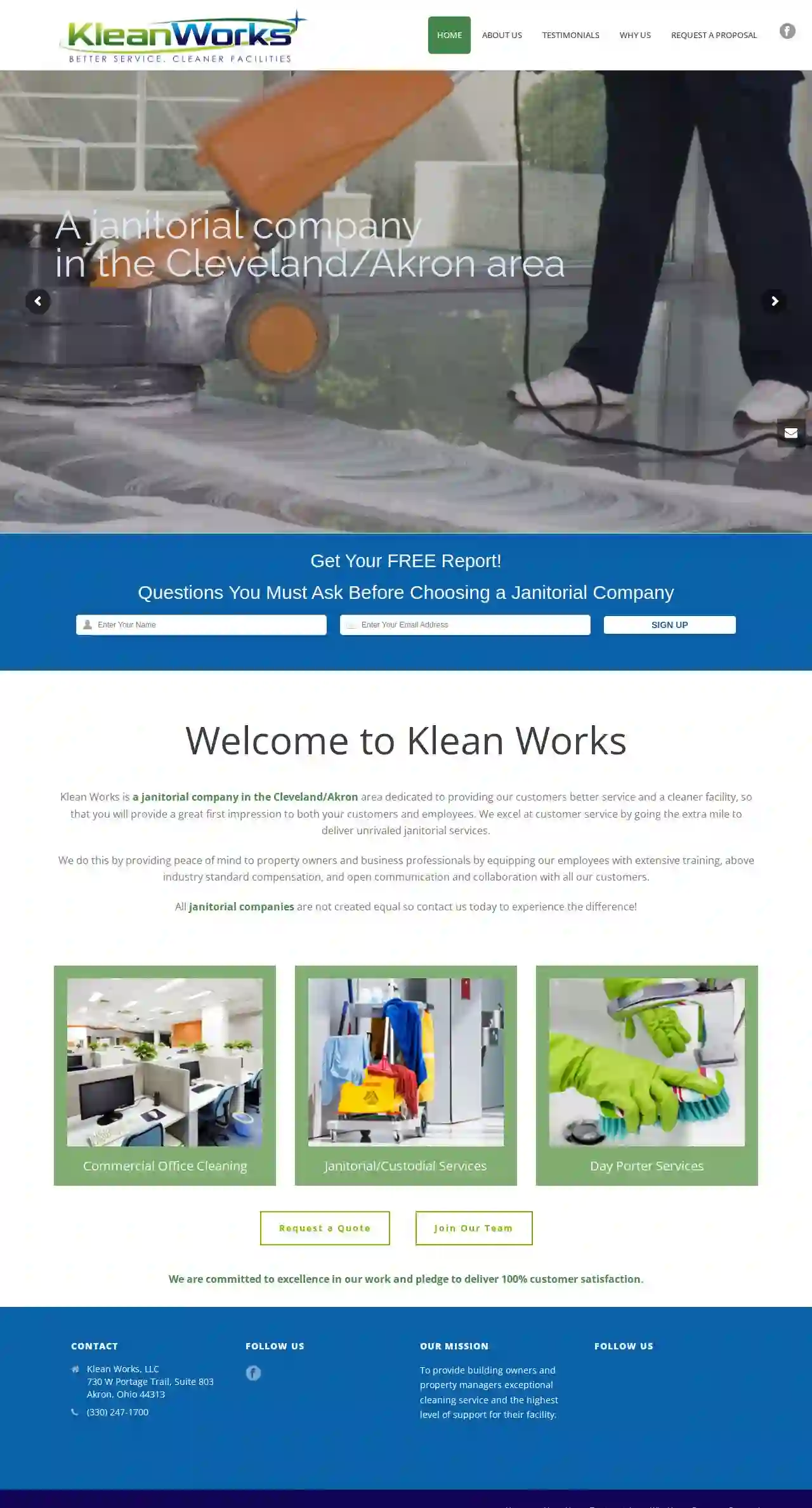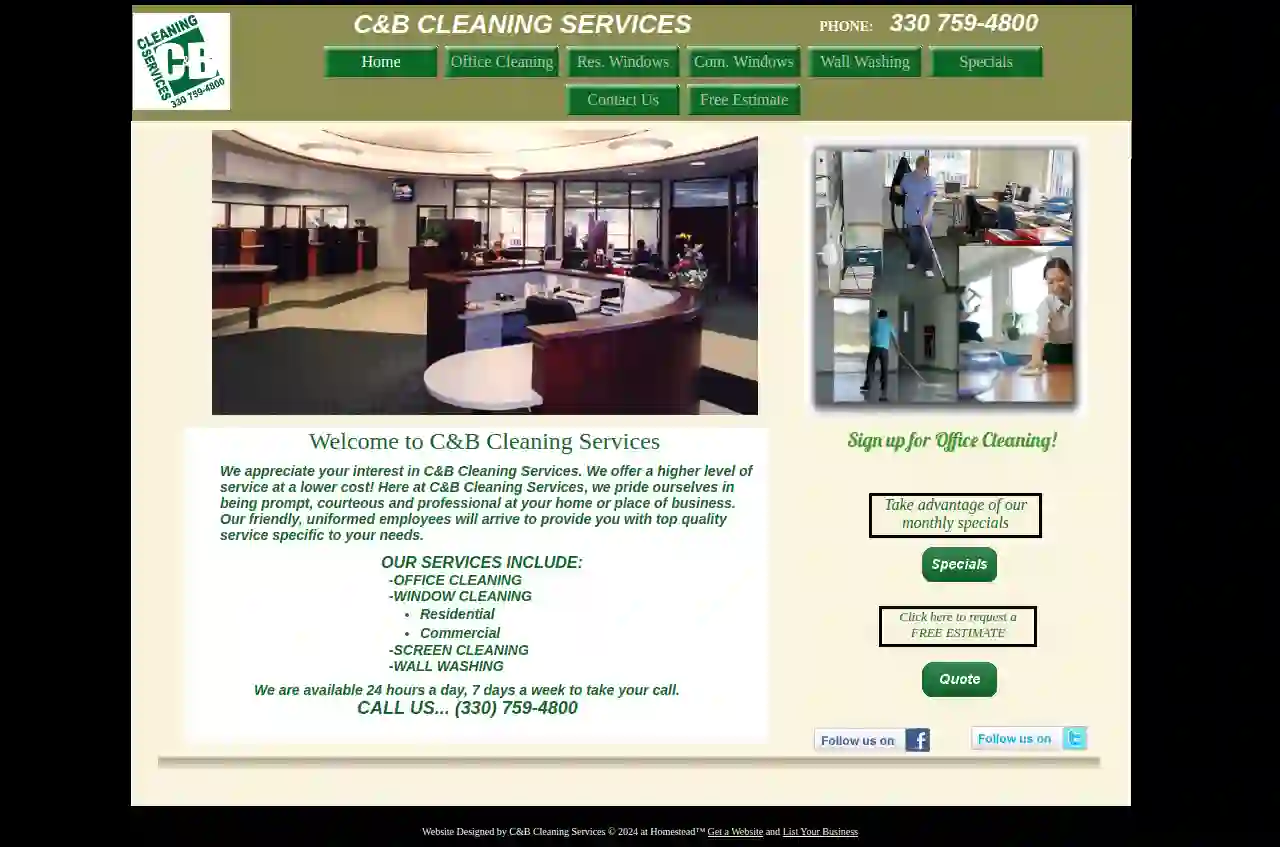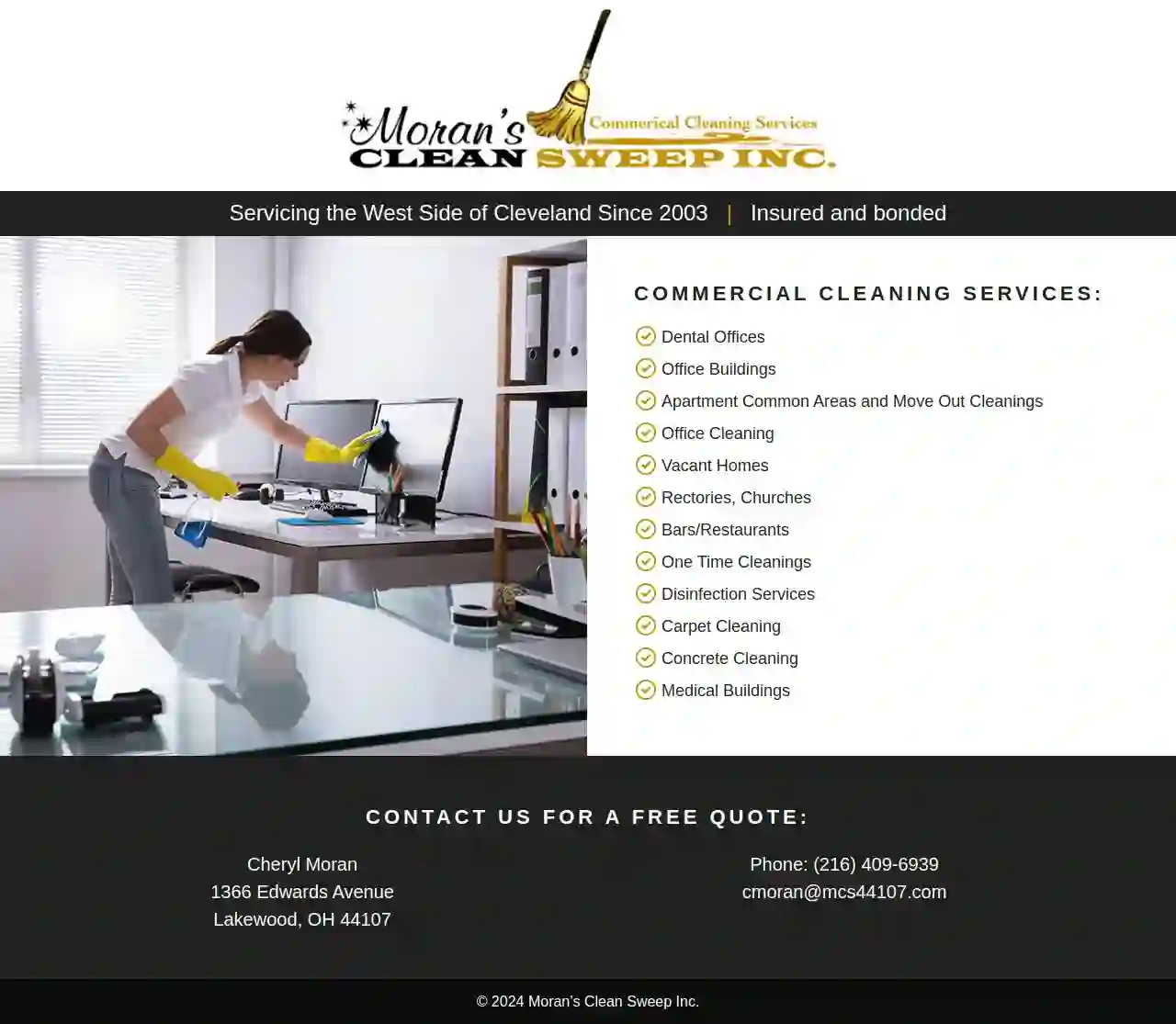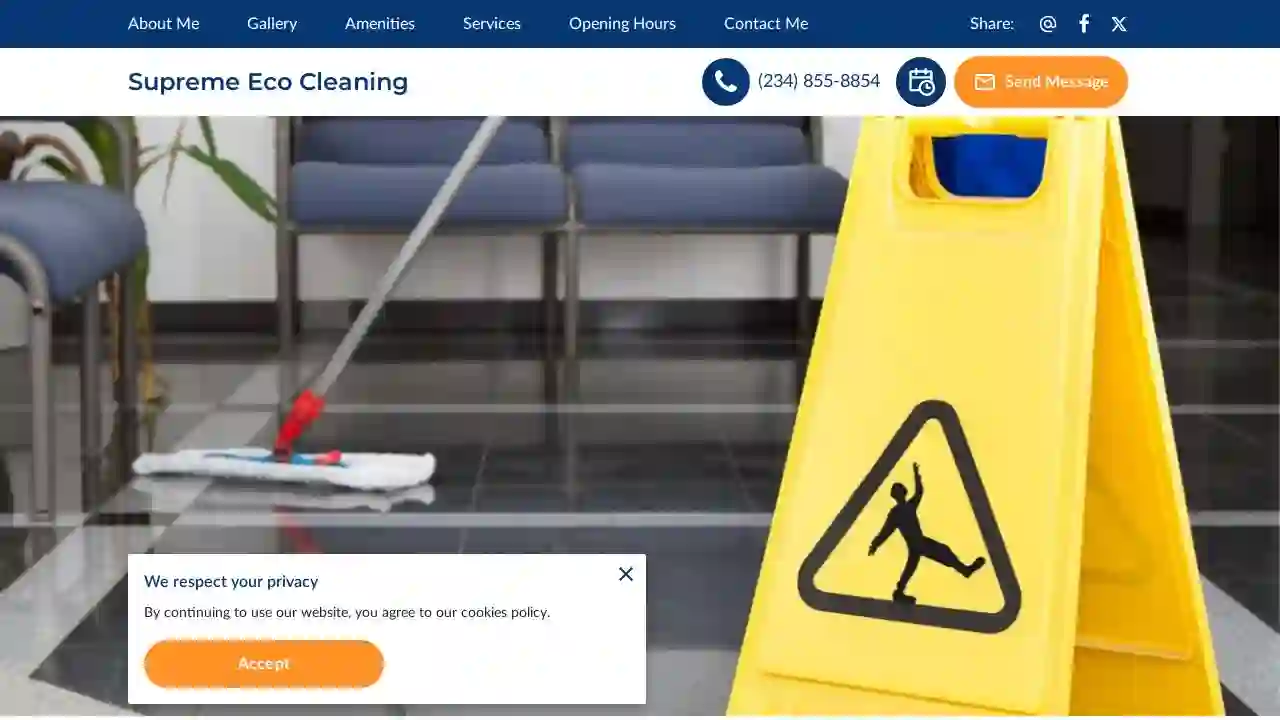Cleaning Services Germantown
Top 10 Local Cleaners in Germantown
Get multiple Cleaning quotes for your project today! Compare profiles, reviews, accreditations, portfolio, etc... and choose the best deal.

Klean Works, LLC
51 reviewsSuite 803, 730 W Portage Trail, Akron, 44313, USKlean Works is a dedicated janitorial company in the Cleveland/Akron area, providing exceptional cleaning services and unrivaled customer support. We prioritize customer satisfaction and employee training to ensure a cleaner facility and a great first impression for both customers and employees. Our mission is to deliver 100% customer satisfaction and provide building owners and property managers with exceptional cleaning service and the highest level of support for their facility.
- Services
- Why Us?
- Accreditations
- Our Team
- Testimonials
- Gallery
Get Quote
Clean Team Youngstown
59 reviewsYoungstown, US- Services
- Why Us?
- Gallery
Get Quote
C&B Cleaning Services
511 reviewsYoungstown, USC&B Cleaning Services offers a higher level of service at a lower cost. Our friendly, uniformed employees will arrive to provide you with top quality service specific to your needs. We offer 10 years experience and we are insured and bonded. We provide our own supplies and equipment, so there is no need for our customers to worry about anything. We offer both exterior and interior window cleaning or if you prefer we offer exterior service only. The choice is yours.
- Services
- Why Us?
- Accreditations
- Testimonials
- Gallery
Get Quote
Merry Maids of Akron
4.543 reviewsAkron, US- Services
- Why Us?
- Gallery
Get Quote
Blue Sky Commercial Cleaning Service
58 reviewsNewark, US- Services
- Why Us?
- Gallery
Get Quote
All Solutions Cleaning and Maintenance
215 Union Blvd, Suite 175, Lakewood, 80228, USAll Solutions Cleaning and Maintenance is a locally-owned company that provides a variety of office cleaning and janitorial services. We are dedicated to providing reliable, trustworthy, and responsive cleaning services for offices and commercial buildings across the Denver metro area. Our cleaning crews are friendly, courteous, conscientious, and honest, and they all wear identifiable uniforms and ID badges. We are hands-on owners who will get to know your property and your tenants, and who will promptly address your questions and concerns. We are available to you 24 hours a day, seven days a week. We look forward to hearing from you soon!
- Services
- Why Us?
- Accreditations
- Our Team
- Testimonials
- Gallery
Get Quote
VZ Cleaning Services
597 reviewsYoungstown, US- Services
- Why Us?
- Gallery
Get Quote
Moran's Clean Sweep Inc.
51 reviews1366 Edwards Avenue, Lakewood, 44107, USMoran's Clean Sweeping is a commercial cleaning service that has been serving the West Side of Cleveland since 2003. They are insured and bonded, offering a variety of cleaning services including dental offices, office buildings, apartment common areas and move out cleanings, office cleaning, vacant homes, rectories, churches, bars/restaurants, one-time cleanings, disinfection services, carpet cleaning, and medical buildings. For a free quote, contact Cheryl Moran at (216) 409-6939 or [email protected].
- Services
- Why Us?
- Accreditations
- Our Team
- Testimonials
- Gallery
Get Quote
Awesome A's Cleaning Service
518 reviewsAkron, US- Services
- Why Us?
- Gallery
Get Quote
Supreme Eco Cleaning
123 Clean St, Youngstown, Ohio, Youngstown, Ohio, USSupreme Eco Cleaning is a top-rated janitorial service in Youngstown, Ohio, dedicated to providing the best commercial and domestic cleaning services. With a focus on detail and customer satisfaction, we offer a range of services including home and condo cleaning, office and restroom services, apartment move-in/move-out cleaning, carpet cleaning, pressure washing, and floor stripping and waxing. Our team is fully trained to use state-of-the-art cleaning tools and materials to ensure your space is pristine. We are available 24/7 and accept debit and credit cards for your convenience. Our mission is to provide hassle-free cleaning services that meet your needs and exceed your expectations.
- Services
- Why Us?
- Accreditations
- Our Team
- Testimonials
Get Quote
Over 60,241+ Janitorial Services on our directory
Our cleaning service providers operate in Germantown and beyond!
CleaningMatch has curated and vetted the Best Cleaning Services in Germantown. Find the most reliable business today.
Frequently Asked Questions About Cleaning Services
- Declutter first: Before cleaning, declutter surfaces and remove any items that don't belong. This makes cleaning easier and prevents distractions.
- Gather your supplies: Assemble all your cleaning supplies, including cleaners, cloths, sponges, and a trash bag, in a caddy or bucket to avoid wasting time searching for them.
- Work from top to bottom: Start cleaning from the top of each room and work your way down to prevent dust and debris from falling on already cleaned surfaces.
- Focus on high-traffic areas: Pay extra attention to high-traffic areas like kitchens and bathrooms, where dirt and germs accumulate quickly.
- Use the right tools: Utilize appropriate cleaning tools for different surfaces and tasks. Microfiber cloths are effective for dusting and cleaning glass, while scrub brushes are ideal for tough stains.
- Clean in sections: Break down larger tasks into smaller sections to avoid feeling overwhelmed. Focus on one area at a time before moving on to the next.
- Establish a routine: Create a regular cleaning schedule and stick to it. This prevents dirt buildup and makes cleaning more manageable.
- Clean Pet Bedding: Wash pet bedding regularly in hot water to remove odors and bacteria.
- Vacuum Thoroughly: Vacuum carpets, rugs, and upholstery frequently using a vacuum cleaner with a pet hair attachment.
- Enzyme Cleaners: Use enzyme cleaners specifically designed for pet odors. These cleaners break down the odor-causing molecules.
- Baking Soda: Sprinkle baking soda on carpets and upholstery, let it sit for a few hours, then vacuum. Baking soda absorbs odors.
- Air Fresheners: Use air fresheners or diffusers to mask odors temporarily.
- Professional Cleaning: For persistent odors, consider hiring a professional cleaning service specializing in pet odor removal.
- Using the wrong cleaning products: Certain cleaning products are unsuitable for specific surfaces. Using abrasive cleaners on delicate surfaces can cause scratches or discoloration.
- Not reading product instructions: Always read and follow the instructions on cleaning products to ensure proper usage and avoid potential hazards.
- Using dirty cleaning tools: Dirty cloths, sponges, and mops can spread germs and dirt instead of cleaning them. Rinse and sanitize your cleaning tools regularly.
- Skipping ventilation: Proper ventilation is essential when using cleaning products, especially those with strong fumes. Open windows and doors to allow fresh air circulation.
- Not allowing sufficient drying time: After cleaning, allow surfaces to dry completely to prevent mold and mildew growth, particularly in humid areas like bathrooms.
- Ignoring clutter: Clutter makes cleaning more difficult and time-consuming. Declutter regularly to maintain a cleaner and more organized home.
- Floors: Use floor cleaners designed for your specific floor type, such as hardwood, tile, or laminate. Avoid using harsh cleaners that can strip finishes or cause discoloration.
- Countertops: Clean granite, marble, or quartz countertops with pH-neutral cleaners to prevent etching or damage. Use disinfecting wipes or sprays for other countertops.
- Bathrooms: Use bathroom cleaners designed to remove soap scum, mildew, and hard water stains. Avoid using abrasive cleaners on fixtures or tiles.
- Glass and Mirrors: Clean windows and mirrors with glass cleaners that leave a streak-free finish. Avoid using paper towels, which can leave lint behind.
- Appliances: Clean stainless steel appliances with specialized cleaners that prevent streaks and fingerprints. Use degreasers for ovens and stovetops.
What are some tips for cleaning my own home efficiently?
By implementing these strategies, you can clean your home more efficiently and maintain a cleaner and healthier living space.
How do I get rid of pet odors in my home?
Regular cleaning, enzyme cleaners, and baking soda are effective methods for eliminating pet odors and maintaining a fresh-smelling home.
What are some common cleaning mistakes to avoid?
By avoiding these common cleaning mistakes, you can improve your cleaning efficiency and achieve better results.
How do I choose the right cleaning products for different surfaces?
If you're unsure about the right cleaning product for a surface, consult the manufacturer's instructions or seek advice from a cleaning professional.
What are some tips for cleaning my own home efficiently?
- Declutter first: Before cleaning, declutter surfaces and remove any items that don't belong. This makes cleaning easier and prevents distractions.
- Gather your supplies: Assemble all your cleaning supplies, including cleaners, cloths, sponges, and a trash bag, in a caddy or bucket to avoid wasting time searching for them.
- Work from top to bottom: Start cleaning from the top of each room and work your way down to prevent dust and debris from falling on already cleaned surfaces.
- Focus on high-traffic areas: Pay extra attention to high-traffic areas like kitchens and bathrooms, where dirt and germs accumulate quickly.
- Use the right tools: Utilize appropriate cleaning tools for different surfaces and tasks. Microfiber cloths are effective for dusting and cleaning glass, while scrub brushes are ideal for tough stains.
- Clean in sections: Break down larger tasks into smaller sections to avoid feeling overwhelmed. Focus on one area at a time before moving on to the next.
- Establish a routine: Create a regular cleaning schedule and stick to it. This prevents dirt buildup and makes cleaning more manageable.
By implementing these strategies, you can clean your home more efficiently and maintain a cleaner and healthier living space.
How do I get rid of pet odors in my home?
- Clean Pet Bedding: Wash pet bedding regularly in hot water to remove odors and bacteria.
- Vacuum Thoroughly: Vacuum carpets, rugs, and upholstery frequently using a vacuum cleaner with a pet hair attachment.
- Enzyme Cleaners: Use enzyme cleaners specifically designed for pet odors. These cleaners break down the odor-causing molecules.
- Baking Soda: Sprinkle baking soda on carpets and upholstery, let it sit for a few hours, then vacuum. Baking soda absorbs odors.
- Air Fresheners: Use air fresheners or diffusers to mask odors temporarily.
- Professional Cleaning: For persistent odors, consider hiring a professional cleaning service specializing in pet odor removal.
Regular cleaning, enzyme cleaners, and baking soda are effective methods for eliminating pet odors and maintaining a fresh-smelling home.
What are some common cleaning mistakes to avoid?
- Using the wrong cleaning products: Certain cleaning products are unsuitable for specific surfaces. Using abrasive cleaners on delicate surfaces can cause scratches or discoloration.
- Not reading product instructions: Always read and follow the instructions on cleaning products to ensure proper usage and avoid potential hazards.
- Using dirty cleaning tools: Dirty cloths, sponges, and mops can spread germs and dirt instead of cleaning them. Rinse and sanitize your cleaning tools regularly.
- Skipping ventilation: Proper ventilation is essential when using cleaning products, especially those with strong fumes. Open windows and doors to allow fresh air circulation.
- Not allowing sufficient drying time: After cleaning, allow surfaces to dry completely to prevent mold and mildew growth, particularly in humid areas like bathrooms.
- Ignoring clutter: Clutter makes cleaning more difficult and time-consuming. Declutter regularly to maintain a cleaner and more organized home.
By avoiding these common cleaning mistakes, you can improve your cleaning efficiency and achieve better results.
How do I choose the right cleaning products for different surfaces?
- Floors: Use floor cleaners designed for your specific floor type, such as hardwood, tile, or laminate. Avoid using harsh cleaners that can strip finishes or cause discoloration.
- Countertops: Clean granite, marble, or quartz countertops with pH-neutral cleaners to prevent etching or damage. Use disinfecting wipes or sprays for other countertops.
- Bathrooms: Use bathroom cleaners designed to remove soap scum, mildew, and hard water stains. Avoid using abrasive cleaners on fixtures or tiles.
- Glass and Mirrors: Clean windows and mirrors with glass cleaners that leave a streak-free finish. Avoid using paper towels, which can leave lint behind.
- Appliances: Clean stainless steel appliances with specialized cleaners that prevent streaks and fingerprints. Use degreasers for ovens and stovetops.
If you're unsure about the right cleaning product for a surface, consult the manufacturer's instructions or seek advice from a cleaning professional.